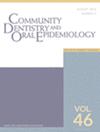To determine the effect of social mobility on self-perceived oral health (SPOH) by: (i)characterizing patterns of social mobility from birth to adulthood and (ii)assessing their influence on SPOH among British adults.
A secondary data analysis of the 1970 British Cohort Study. Data were collected at birth and at 5, 10, 16, 26, 30, 34, 38, 42 and 46 years of age. Social class (SC) was indicated by parental SC from birth to age 16 and own SC from ages 26 to 42. At age 46, SPOH was measured using a single question. Sex, ethnicity, country and residence area were included as potential confounders. Latent class growth analysis (LCGA) was used to identify trajectories of exposure to non-manual SC over time, instead of predetermined categories.
LCGA identified four social mobility patterns: stable high, stable low, upwardly mobile and downwardly mobile; the time for the change in SC happening between 16 and 26 years. A total of 9657 participants were included. In the crude model, stable high had lower odds (OR: 0.67, 95% CI: 0.59–0.76), while downward mobility and stable low had higher odds (OR: 1.36, 95% CI: 1.15–1.61 and OR: 1.57, 95% CI: 1.40–1.77) of poor SPOH than upward mobility. These results were corroborated in the fully adjusted model; being female and living in rural areas was also associated with lower odds (OR: 0.64, 95% CI: 0.59–0.71 and OR: 0.90, 95%CI: 0.80–1.00) of poor SPOH.
Social mobility significantly affects SPOH in British adults. Those in non-manual SC have better SPOH than those in manual SC. When compared to upward mobility, downwardly mobile individuals report bad SPOH more frequently, evidencing that current SC influences oral health in a slightly greater measure than early years SC.



